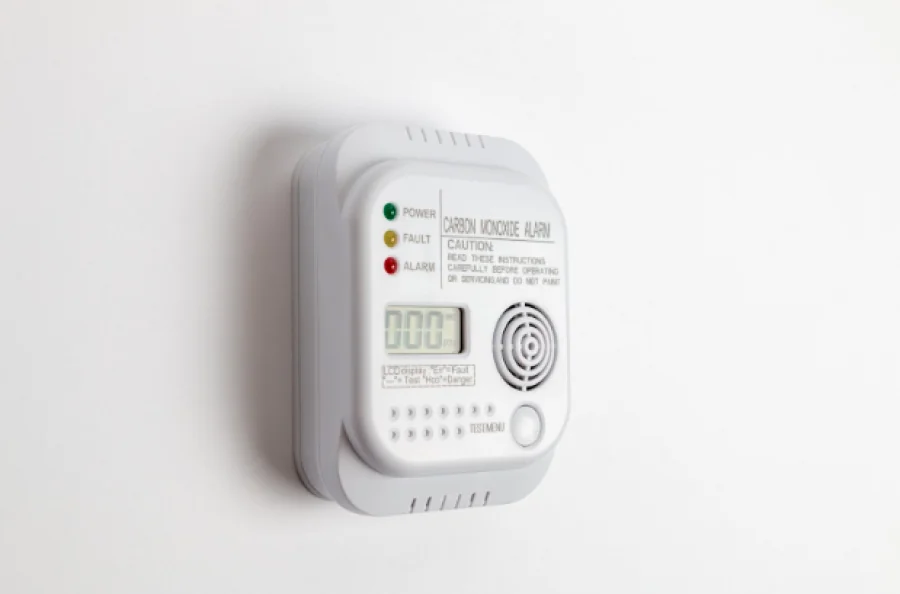Your carbon monoxide detector may sound for reasons other than carbon monoxide buildup in your home. At Star Heating & Cooling we place a priority on carbon monoxide alarms otherwise known as CO detectors. These devices save lives by alerting you to natural gas leaks and other sources of deadly carbon monoxide. So before we discuss the reasons carbon monoxide detectors may present a false alarm or a nuisance alarm, an alarm from your carbon monoxide detectors should never be ignored. Carbon monoxide detectors are invaluable safety devices for your home and family.
Let’s first consider how to respond when a CO detector sounds and learn the symptoms of carbon monoxide exposure. Secondly, you should know what carbon monoxide does, the symptoms of carbon monoxide poisoning, and finally why your carbon monoxide detector beeping may be a false alarm.
How To Respond To A Carbon Monoxide Alarm
A carbon monoxide detector protects your home by measuring the parts per million of carbon monoxide in the air. When levels are too high an alarm sounds. As soon as a carbon monoxide detector sounds you should react swiftly. Even if you are not experiencing symptoms or warning signs of carbon monoxide buildup in your home, you should act immediately.
- Move all family members from your home. Pets should be removed from the home as well.
- As you exit, leave windows and doors open to help dissipate carbon monoxide.
- Once all family members are safely out of your home, call authorities.
- Even if an alarm stops, do not reenter until authorities verify the home is safe.
- Movement within the home, open doors, and windows may reduce the carbon monoxide build-up but does not eliminate the source or leak.
- Emergency responders will determine the cause of carbon monoxide and advise you on the next steps.
What Are The Symptoms Of Carbon Monoxide Poisoning?
First responders will likely talk to you and your family about symptoms. If you experience any issues you should contact medical professionals. A number of the most common symptoms of carbon monoxide exposure are:
- Confusion
- Headache
- Dizziness
- Fatigue
- Blurred vision
- Weakness
- Chest pain
- Flu-like symptoms
How A Carbon Monoxide Detector Works
Carbon monoxide detectors work like smoke detectors in your home. An electrochemical sensor measures part per million levels within your home. There are natural sources of carbon monoxide within your home.
Sources of carbon monoxide in your home include any fuel-burning appliance:
- Stoves and gas ranges
- Fireplaces
- Furnaces
- Water heaters
- Vehicles in garage
- Space heaters
Poor ventilation in kitchens, garages, and other areas within your home can lead to a build-up of deadly gas. These events are so common that smoke alarms are often integrated with CO alarms. To protect your home from carbon monoxide it is vital to properly mount, maintain and respond to monoxide alarms.
Why Is A Carbon Monoxide Detector Going Off?
Let’s assume your local fire department has tested and verified a false alarm occurred. To prevent false alarms from your carbon monoxide detector there are a few steps you can take to remedy the issue before calling on professional specialists.
Maintenance Of Carbon Monoxide Detectors
Prevention of nuisance alarms includes following all recommendations of the manufacturer. Testing monthly, replacing batteries every 6 months and gently removing dust from the CO alarm is best practice. A carbon monoxide detector beeping is also referred to as a chirp. A chirp may alert you to maintenance warnings including:
- A low battery warning
- Warning of malfunction
- End-of-life warning
Other Causes Of False Alarms
Lack of maintenance may not be the cause of carbon monoxide false alarms. One of the most common issues is improper installation. When a carbon monoxide detector is installed in the wrong location the device is not as effective to prevent carbon monoxide poisoning and may result in false alarms.
Common causes of false alarms of carbon monoxide:
- Close to cooking sources (10 feet minimum)
- Close to sources of humidity (10-20 feet)
- Near fireplaces
- Near water heaters
- Near furnaces
- Located in a poorly ventilated location like a garage, kitchen, or closet
Call For Professional Help
Carbon monoxide poisoning is far more common than many homeowners realize. At least 50,000 people visit emergency rooms each year with symptoms of carbon monoxide poisoning. Inarguably, carbon monoxide detectors save lives. Every home should include carbon monoxide detectors. Each level of your home should feature at least one. Depending on the size and design of your home more detectors should be installed.
At Star Heating & Cooling we encourage our customers to install, maintain and contact our team for inspections of detectors. We help protect your family against dangerous levels of carbon monoxide by installing equipment in the ideal locations. For existing detectors, most devices should be replaced after 10 years. If you are unsure of the age of your equipment, professional installers mark an installation date on the device. Whether you are experiencing issues, considering upgrading to new equipment, or installing carbon monoxide detectors for the first time, Star Heating and Cooling can help with affordable solutions and friendly service.

